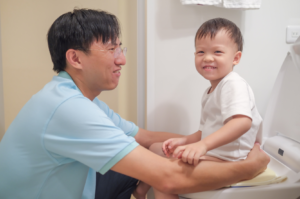Toilet Training/Toilet Learning
Learning to use the toilet is a milestone for children. Some children may be ready for toilet training as young as eighteen months, but most start between two and four years of age.
How long will toilet training take?
Learning to stay dry during the day takes a child about six months. Children usually learn to control their bowels before or at the same time. Staying dry at night may take longer, even months to years longer.
How will I know when my child is ready?

To start toilet training, a child should be able to:
- Walk to the bathroom.
- Sit up on the toilet.
- Stay dry for several hours or wake up dry after a nap.
- Pull clothes up and down.
- Follow simple directions, e.g., wash your hands.
- Tell you they need to go to the toilet.
- Show interest in toilet training.
- Show a desire to please.
- Copy what adults and older children do.
The Canadian Pediatric Society recommends that parents Plan, Practice, Praise, and Be Patient. Visit the link to get more information.
Why is my child having accidents?
Toilet training can be a challenging process. It is entirely normal for a child to have accidents. Remind your child to slow down and take a potty break:
- when playing
- after meals
- before a car trip
- before going to bed
Even after your child has been toilet trained, changes in their daily routine can lead to accidents.
If your child is not progressing with toilet training and is between two and four years old, try taking a break for two to three months. If your child is over four years of age, is healthy, and is not toilet trained after several months of trying, talk with your child’s healthcare provider.
Bedwetting is another common accident affecting children up to age six and even longer for some children. Most children will outgrow bedwetting over time.
What do I do if my child refuses to use the toilet?
Refusing to go to the toilet is also a common concern of parents. Some children are willing to use the toilet to pee but will not use it to poop. If this happens, you can try the following:
- Pause toilet training for a few weeks.
- Let your child have complete control over toilet training; for example, try not to remind them to use the toilet.
- Encourage your child to copy you by inviting the child into the bathroom with you.
- Check for constipation. Sometimes this happens if your child holds in their poop when they need to go, leading to painful or difficult bowel movements and setback toilet training.
- Create a star or sticker chart and reward your child when they try to use the toilet and when they successfully use it.
When do I need to seek medical help?
Talk to your healthcare provider if your child:
- Does not use the toilet by age four.
- Used the toilet well for six months or more but seems to be slipping back.
- Is withholding stool, experiences pain when using the potty, or has blood in the poop.
- Develops redness or rash around the vagina or penis; their pee is foul smelling or cloudy or suddenly needs to go more frequently or urgently.
Punishment is not a recommended tool for toilet training. If your child is having difficulty, putting the training on hold for a few weeks may help.
Check out these books at your local library!
- The Princess and the Potty (Wendy Cheyette Lewison)
- The New Potty (Mercer Mayer & Gina Mayer)
- Potty (Leslie Patricelli)
- P is for Potty! (Naomi Kleinberg)
Services related to this information:
- Contact your Public Health Nurse:
- 811 HealthLine (Newfoundland & Labrador) – Call 811 or 1-888-709-2929 / TTY 1-888-709-3555

